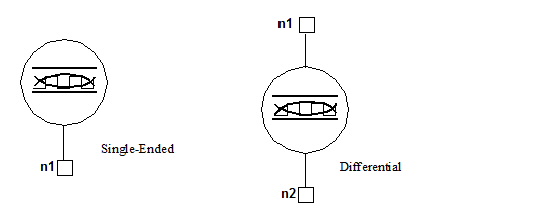|
微波射频仿真设计 |
|
|
微波射频仿真设计 |
|
| 首页 >> Ansoft Designer >> Ansoft Designer在线帮助文档 |
|
Nexxim Simulator > Eye Source
 Eye Source Netlist FormatAn eye source is inserted in a schematic to perform VerifEye analysis, QuickEye analysis, or Transient analysis. The netlist syntax for the Eye Source is: AEYESOURCExxxx n1 [n2]
COMPONENT=EYE_SOURCE n1 is the node connected to the single-ended source. n2 is the second node on a differential source. The differential Eye source must be connected to two signal lines. Neither node should be directly grounded. See Notes below for details. The entry COMPONENT=EYE_SOURCE is required.
Eye Source Netlist ExampleAEYESOURCE3 Port1 COMPONENT=EYE_SOURCE RESISTANCE=50
Notes1. The Single-Ended Eye source has the generalized internal structure below:
The internal voltage source amplitude is set by VHIGH and VLOW. The source is grounded internally. The series resistance is set by the RESISTANCE parameter. 2. The Differential Eye source has the generalized internal structure below:
Each of the two nodes is driven with half the voltage amplitude of the single-ended source and opposite polarity. The output is symmetrical in that the average of the two outputs is close to zero. The series resistance is also divided equally between the two nodes. Both sources are internally grounded. 3. The Single-Ended Eye source connects to a signal line. The line should not be directly grounded. The corresponding Eye probe should also connect to the signal line without any direct ground connection. 4. The Differential Eye source connects to two signal lines. Neither node should be grounded. The corresponding Differential Eye probe should connect to the same two signal lines without direct grounding. 5. For more information on the Eye Source equalization and jitter parameters, see Quick Eye and VerifEye Technical Notes.
HFSS视频教程 ADS视频教程 CST视频教程 Ansoft Designer 中文教程 |
|
Copyright © 2006 - 2013 微波EDA网, All Rights Reserved 业务联系:mweda@163.com |
|